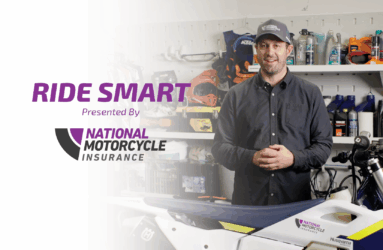2017 KTM EXC Range: Design Philosophy
KTM’s Joachim Sauer articulates the design philosophy of the 2017 enduro bikes from the Austrian brand, and what we can expect from the EXC range in future years.
Former European Enduro and ISDE Champion, Joachim Sauer, has been testing and developing KTM’s off-road motorcycles since the mid 1980s. He’s a candid, colourful and fun-loving character and has played a pivotal role in the Austrian company’s incredible success in the off-road market. We sat down with “Jochi” at the Spanish launch for KTM’s 2017 enduro bikes to get a better feel for the design philosophy behind these new-generation bikes and what we can expect to see from KTM in the coming years.
TM: The design philosophy KTM articulated for the 2017 EXCs is virtually identical to what we hear 12 months ago with KTM’s new-gen MX machines – more power and agility, better handling, improved appearance.
JS: These new enduro models are based on the 2016 motocrossers, so it follows that the benefits of the design philosophy are also the same. So, yes, the enduro and MX models now use the same platform, but it’s important to understand that the 2017 EXC range does not simply take all the components from the 2016 MX models. For instance, even though the enduro and MX models’ frames use a very similar architecture, the 2017 EXC models do not get the 10mm shorter wheelbase. They retain the same geometry as their predecessors because we found that it offers the best combination of control and stability.
Many components used in the MX and enduro engines are also different, right?
Absolutely. All the engines’ rotating masses – the crankshaft, camshaft and clutch – have all been optimised for enduro applications on these new EXC models. The piston, gearbox and mapping are all completely different on the enduro models, too.
Is this 2017 EXC range more significant than the last major upgrade back in 2012?
It’s certainly the most significant upgrade since the step we took between 2011 and 2012. In fact, I think it’s fair to say these 2017 bikes are an even bigger step forward – and not just in terms of weight savings and handling gains. The 2017 bikes represent a new benchmark in the evolution of KTM’s enduro models. For 2012, some of the existing engines were refined. But in 2017, every single displacement – two-stroke and four-stroke – gets a new engine, as well as an all-new frame, suspension and bodywork. It’s the first time we’d had such a completely new story.
That’s quite an undertaking for KTM’s design team.
Yes, our design team has been extremely busy, and that’s before you consider the need for Euro IV homologation. For customers, homologation is simply a background issue; they do not want to know about a new set of regulations affecting the bikes’ performance. But for designers, homologation brings with it a massive amount of added work. It is critical for us to keep our models as ‘ready to race’ as they have ever been, while abiding by the new rules fully. And that process will continue in future years, too. In addition to reduced noise and emissions, there will also be new requirements for things like evaporation systems and onboard diagnostics. So their life will not be getting any easier [laughs].
“The 2017 bikes represent a new benchmark in the evolution of KTM’s enduro models. Every single displacement gets a new engine, as well as an all-new frame, suspension and bodywork.”
There are some enormous advances made with this 2017 range – reduced weight and vibration, mass centralisation, broader power, etcetera. But what do you see as the most significant achievement for 2017?
I would say the 250 and 300cc two-strokes, and not just because they are completely new and represent such a large step up from their predecessors. Remember that this is the first time we are seeing these all-new engines, whereas the new-generation four-stroke models’ engines were unveiled a year ago in the motocross range. So for us, it has been very exciting here at the EXC launch to allow the media to experience the all-new two-stroke models for he first time ever. And we are pleased to say that the 250 and 300EXC were extremely well received.
A couple of years ago, you led me to believe that to meet Euro IV emission regs, your 2017 two-strokes would lose their carbs and move to direct injection. What happened?
The Euro IV regulations come into effect on January 1, 2017, so there is a transition period that allows us to continue with the carburetor on our two-strokes. For the 2018 model-year, however, we will be prepared to deliver bikes with Euro IV homologation here in Europe. But for the bikes we send to Australia, where the emission regulations are not as strict, we definitely will not be introducing the direct fuel injection system initially. It will be fitted when absolutely required.
Is that decision based on differences in cost or performance, or both?
We believe the customer is not yet 100 percent convinced whether or not fuel injection will be an advantage. Plus a major issue is that, when the two-strokes are fitted with fuel injection, these models will come with a price increase that will make them close to the four-strokes.
But the change to a Mikuni carb this year will also mean added costs for consumers, won’t it?
Yes, but to a lesser extent. Moving from the Keihin to Mikuni carb was not an easy decision for us. After all, we’ve had so many years of built-up experience and knowledge with jetting. But it was impossible for us to overlook the fact the Mikuni carb works better with our new engines by making smoother, more rideable power. Plus Mikuni was much more prepared to work collaboratively with KTM to modify their carbs. But you are right in saying that it will add some cost because consumers won’t be able to use any of their old Keihin jets.
“For the two-strokes sent to Australia, where the emission regulations are not as strict, we will not be introducing the direct fuel injection system initially. It will be fitted when absolutely required.”
KTM did a damn good job of keeping the new XPlor suspension under wraps until this launch. Was there ever any thought of the enduro models getting the same air-sprung WP AER fork that now comes in the motocross bikes?
For trail, enduro, cross-country and desert racing applications, we believe it is still too early to consider an air fork. Our take is that consumers do not yet trust the reliability of air suspension when riding in remote terrain. I think we will need another three to five years for these perceptions to change, and to convince people that an air fork could be an advantage – aside from the weight reduction it offers. That same rationale is behind our decision to leave the kick-starter in place on the two-stroke models as a back-up to the electric starter. The next-generation of two-strokes will not have a kick-starter as standard equipment. Combined with the change to the engine cases, that will save 1.5kg.
Why the move to the XPlor fork and shock for 2017? After all, WP’s refined PDS shock and open-cartridge fork are widely regarded as one of the best suspension packages on the market.
Well, it’s simply a matter of evolution. You never stand still. The XPlor suspension gives us weight savings and improved access to clicker adjustment. I mean, riders should not have to use a screwdriver to adjust the fork’s clickers. This new suspension package is definitely a step forward.
There’s been a lot of talk here at the launch about the four-strokes’ traction control and the ingenious the tool-free fork spring preload adjuster.
Yes, and they are both unique to KTM. We always strive to be ahead and to introduce technology that is beneficial to the rider. I think the traction control is a great feature because everybody from an amateur to a Pro can really benefit from it. If the rider is tired, or if the weather or terrain suddenly changes, there is added traction at the push of a button. It really works in giving the rider so much more control.
But the map-selector switch doesn’t come as standard equipment on the two- or four-stroke models. Why put a ‘paywall’ in front of the very handy traction control function?
Because not everybody wants that feature. If they do, they’re available through PowerParts, or they can buy a Six Days model, where that switch – along with many other premium parts, including the new tool-free fork preload adjuster – comes as standard equipment.
“There will be refinements in the meantime, but year-model 2020 is when you can expect to see the next ‘new-generation’ EXC models with major upgrades.”
You’ve said the design team spent a lot of time and effort into fine-tuning the bodywork. Where and why?
It’s always the small details that we spend time and money on. In response to our enduro guys’ requests, we focused on making the bodywork narrower around the silencer, but a little wider at the front of the sideplates to allow them to grip the bike better with their legs and reduce the load on their hands. And we put a lot of work into enlarging the contact area with the rider’s knees. The bodywork is also a little higher in that area to ensure there’s nothing to catch your boots on. Same with the area above the radiators to enlarge the sliding surface.
Obviously the focus is on these new-generation 2017 bikes. But what can you tell us about future models, Jochi?
I can simply tell you that the lights at KTM – especially in our R&D department – are never switched off. We have our new-model lifecycles defined and we are already working intensively on the next generation of bikes. A new set of ‘Euro V’ regulations comes into effect for 2020, and this will again have implications for our bikes’ design. So of course we will see refinements to the bikes in the meantime, but year-model 2020 is when you can expect to see the next ‘new-generation’ EXC models with major upgrades and a different appearance.
RELATED ARTICLES…
- Click here for candid insights into the new technology integrated into KTM’s 2017 enduro range from the brand’s main R&D man, Bernhard Plazotta.
- Click here for an interview with KTM’s Michael Viertlmayr, the engineer credited with designing KTM’s new-generation powerplants.
- Click here for our ride impression of KTM’s 2017 EXC range from the international launch in Spain.














Be the first to comment...